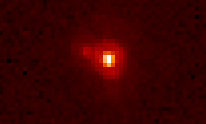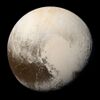Astronomy:(55637) 2002 UX25
 2002 UX25 and satellite, as seen by Hubble | |
| Discovery[1] | |
|---|---|
| Discovered by | Spacewatch (291) |
| Discovery site | Kitt Peak National Obs. |
| Discovery date | 30 October 2002 |
| Designations | |
| (55637) 2002 UX25 | |
| Minor planet category | Cubewano (MPC)[2] Extended (DES)[3] |
| Orbital characteristics[1] | |
| Epoch 4 September 2017 (JD 2458000.5) | |
| Uncertainty parameter 2 | |
| Observation arc | 25.26 yr (9,228 days) |
| Earliest precovery date | 12 October 1991 |
| |{{{apsis}}}|helion}} | 48.491 AU |
| |{{{apsis}}}|helion}} | 36.485 AU |
| 42.488 AU | |
| Eccentricity | 0.1413 |
| Orbital period | 276.95 yr (101,157 days) |
| Average Orbital speed | 4.54 km/s |
| Mean anomaly | 295.71° |
| Mean motion | 0° 0m 12.96s / day |
| Inclination | 19.484° |
| Longitude of ascending node | 204.68° |
| |{{{apsis}}}|helion}} | ≈ 5 September 2066[4] ±3 days |
| 279.00° | |
| Known satellites | 1 (ø: 190–260 km)[5][6] |
| Physical characteristics | |
| Mean diameter | 665±29 km[7] 659±38 km[8] |
| Mass | (1.25±0.03)×1020 kg[6] |
| Mean density | 0.82±0.11 g/cm3 (assuming equal densities for primary and satellite)[6] 0.80±0.13 g/cm3[8] |
Equatorial surface gravity | 0.075 m/s2 |
Equatorial escape velocity | 0.227 km/s |
| Rotation period | 14.382±0.001 h[9] |
| Geometric albedo | 0.107+0.005 −0.008[7] 0.1±0.01[8] |
| Physics | ≈ 43 K |
| B–V=1.007±0.043[10] V−R=0.540±0.030[10] V−I=1.046±0.034[10] | |
| Apparent magnitude | 19.8 [11] |
| Absolute magnitude (H) | 3.87±0.02,[9] 4.0[1] |
(55637) 2002 UX25 (provisional designation 2002 UX25) is a trans-Neptunian object that orbits the Sun in the Kuiper belt beyond Neptune. It briefly garnered scientific attention when it was found to have an unexpectedly low density of about 0.82 g/cm3.[12]
2002 UX25 has an absolute magnitude of about 4.0,[1] and Spitzer Space Telescope results estimate it to be about 681 km in diameter.[13] The low density of this and many other mid sized TNOs implies that they have likely never compressed into fully solid bodies, let alone differentiated or collapsed into hydrostatic equilibrium, and so are highly unlikely to be dwarf planets.[14]
It was discovered on 30 October 2002, by the Spacewatch program.[15]
Numbering and naming
This minor planet was numbered (55637) by the Minor Planet Center on 16 February 2003 (M.P.C. 47763).[16] (As of 2023), it has not been named.[17]
Classification
2002 UX25 has a perihelion of 36.7 AU,[1] which it will next reach in 2065.[1] As of 2020, 2002 UX25 is 40 AU from the Sun.[11]
The Minor Planet Center classifies 2002 UX25 as a cubewano[2] while the Deep Ecliptic Survey (DES) classifies it as scattered-extended.[3] The DES using a 10 My integration (last observation: 2009-10-22) shows it with a minimum perihelion (qmin) distance of 36.3 AU.[3]
It has been observed 212 times with precovery images dating back to 1991.[1]
Physical characteristics
A variability of the visual brightness was detected which could be fit to a period of 14.38 or 16.78 h (depending on a single-peaked or double peaked curve).[18] The light-curve amplitude is ΔM = 0.21±0.06.[9]
The analysis of combined thermal radiometry of 2002 UX25 from measurements by the Spitzer Space Telescope and Herschel Space Telescope indicates an effective diameter of 692 ± 23 km and albedo of 0.107+0.005−0.008. Assuming equal albedos for the primary and secondary it leads to the size estimates of ~664 km and ~190 km, respectively. If the albedo of the secondary is half of that of the primary the estimates become ~640 and ~260 km, respectively.[6] Using an improved thermophysical model slightly different sizes were obtained for UX25 and its satellite: 659 km and 230 km, respectively.[8]
2002 UX25 has red featureless spectrum in the visible and near-infrared but has a negative slope in the K-band, which may indicate the presence of the methanol compounds on the surface.[7] It is redder than Varuna, unlike its neutral-colored "twin" 2002 TX300, in spite of similar brightness and orbital elements.
Composition
With a density of 0.82 g/cm3, assuming that the primary and satellite have the same density, 2002 UX25 is one of the largest known solid objects in the Solar System that is less dense than water.[12] Why this should be is not well understood, because objects of its size in the Kuiper belt often contain a fair amount of rock and are hence pretty dense. To have a similar composition to others large KBOs, it would have to be exceptionally porous, which was believed to be unlikely given the compactability of water ice;[6] this low density thus astonished astronomers.[12] Studies by Grundy et al. suggest that at the low temperatures that prevail beyond Neptune, ice is brittle and can support significant porosity in objects significantly larger than 2002 UX25, particularly if rock is present; the low density could thus be a consequence of this object failing to warm sufficiently during its formation to significantly deform the ice and fill these pore spaces.[19]
| What | Density (g/cm3) |
Notes |
|---|---|---|
| Settled snow | 0.2–0.3 | [20] |
| Slush/firn | 0.7–0.8 | [20] |
| 2002 UX25 | 0.82 | [6] |
| Glacier ice | 0.83–0.92 | [20] |
| Tethys | 0.984 | [21] |
| Liquid water | 1 | [20] |
Satellite
| Discovery | |
|---|---|
| Discovered by | Brown et al. |
| Discovery date | 2007 |
| Orbital characteristics | |
| 4750±40 km[22] | |
| Eccentricity | 0.18±0.02[22] |
| Orbital period | 8.3095 d (prograde)[22] |
| Inclination | 63.1°[22] |
| Satellite of | 2002 UX25 |
| Physical characteristics | |
| Mean radius | 105±15 km[23] |
The discovery of a minor-planet moon was reported in IAUC 8812 on 22 February 2007.[5] The satellite was detected using the Hubble Space Telescope in August 2005.[5] The satellite was found at 0.16 arcsec from the primary with an apparent magnitude difference of 2.5.[24] It orbits the primary in 8.309±0.0002 days,[9] at a distance of 4770±40 km, yielding a system mass of (1.25±0.03)×1020 kg.[6][9] The eccentricity of the orbit is 0.17±0.03.[9]
This moon is estimated to be 210±30 km in diameter.[7] Assuming the same albedo as the primary, it would have a diameter of 190 km, assuming an albedo of 0.05 (typical of other cold, classical KBOs of similar size) a diameter of 260 km.[6]
References
- ↑ 1.0 1.1 1.2 1.3 1.4 1.5 1.6 "JPL Small-Body Database Browser: 55637 (2002 UX25)". Jet Propulsion Laboratory. https://ssd.jpl.nasa.gov/sbdb.cgi?sstr=2055637.
- ↑ 2.0 2.1 "MPEC 2009-C70 :Distant Minor Planets (2009 FEB. 28.0 TT)". Minor Planet Center. 2009-02-10. https://www.minorplanetcenter.net/mpec/K09/K09C70.html.
- ↑ 3.0 3.1 3.2 Marc W. Buie. "Orbit Fit and Astrometric record for 55637". SwRI (Space Science Department). http://www.boulder.swri.edu/~buie/kbo/astrom/55637.html.
- ↑ JPL Horizons Observer Location: @sun (Perihelion occurs when deldot changes from negative to positive. Uncertainty in time of perihelion is 3-sigma.)
- ↑ 5.0 5.1 5.2 Daniel W. E. Green (2007-02-22). "IAUC 8812: Sats OF 2003 AZ_84, (50000), (55637), (90482)". International Astronomical Union Circular. http://www.cbat.eps.harvard.edu/iauc/08800/08812.html.
- ↑ 6.0 6.1 6.2 6.3 6.4 6.5 6.6 6.7 M.E. Brown (2013). "The density of mid-sized Kuiper belt object 2002 UX25 and the formation of the dwarf planets". The Astrophysical Journal Letters 778 (2): L34. doi:10.1088/2041-8205/778/2/L34. Bibcode: 2013ApJ...778L..34B.
- ↑ 7.0 7.1 7.2 7.3 Fornasier, S. et al. (2013). "TNOs are Cool: A survey of the trans-Neptunian region. VIII. Combined Herschel PACS and SPIRE observations of 9 bright targets at 70–500 μm.". Astronomy & Astrophysics 555: A92. doi:10.1051/0004-6361/201321329. Bibcode: 2013A&A...555A..15F.
- ↑ 8.0 8.1 8.2 8.3 Brown, Michael E.; Butler, Bryan J. (20 June 2017). "The Density of Mid-sized Kuiper Belt Objects from ALMA Thermal Observations". The Astronomical Journal 154 (1): 19. doi:10.3847/1538-3881/aa6346. Bibcode: 2017AJ....154...19B.
- ↑ 9.0 9.1 9.2 9.3 9.4 9.5 "(55637) 2002 UX25". http://www.johnstonsarchive.net/astro/astmoons/am-55637.html.
- ↑ 10.0 10.1 10.2 Hainaut, O. R.; Boehnhardt, H.; Protopapa, S. (October 2012). "Colours of minor bodies in the outer solar system. II. A statistical analysis revisited". Astronomy & Astrophysics 546: 20. doi:10.1051/0004-6361/201219566. Bibcode: 2012A&A...546A.115H. https://www.aanda.org/articles/aa/pdf/2012/10/aa19566-12.pdf.
- ↑ 11.0 11.1 "AstDys (55637) 2002UX25 Ephemerides". Department of Mathematics, University of Pisa, Italy. https://newton.spacedys.com/astdys/index.php?pc=1.1.3.0&n=2002UX25.
- ↑ 12.0 12.1 12.2 Cowen, Ron (2013). "Astronomers surprised by large space rock less dense than water". Nature News. doi:10.1038/nature.2013.14135.
- ↑ John Stansberry; Will Grundy; Mike Brown; Dale Cruikshank; John Spencer; David Trilling et al. (2008). "Physical Properties of Kuiper Belt and Centaur Objects: Constraints from Spitzer Space Telescope". in M. Antonietta Barucci. The Solar System Beyond Neptune. University of Arizona press. pp. 161–179. ISBN 978-0-8165-2755-7. Bibcode: 2008ssbn.book..161S. http://www.lpi.usra.edu/books/ssbn2008/7017.pdf.
- ↑ W.M. Grundy, K.S. Noll, M.W. Buie, S.D. Benecchi, D. Ragozzine & H.G. Roe, 'The Mutual Orbit, Mass, and Density of Transneptunian Binary Gǃkúnǁʼhòmdímà ((229762) 2007 UK126)', Icarus (forthcoming, available online 30 March 2019) DOI: 10.1016/j.icarus.2018.12.037,
- ↑ Marsden, Brian G. (2002-11-01). "MPEC 2002-V08 : 2002 UX25". IAU Minor Planet Center. Harvard-Smithsonian Center for Astrophysics. https://www.minorplanetcenter.net/mpec/K02/K02V08.html.
- ↑ "MPC/MPO/MPS Archive". Minor Planet Center. https://www.minorplanetcenter.net/iau/ECS/MPCArchive/MPCArchive_TBL.html.
- ↑ "55637 (2002 UX25)". Minor Planet Center. https://www.minorplanetcenter.net/db_search/show_object?object_id=55637.
- ↑ Rousselot, P.; Petit, J.-M.; Poulet, F.; Sergeev, A. Photometric study of Centaur (60558) 2000 EC98 and trans-neptunian object (55637) 2002 UX25 at different phase angles, Icarus, 176, (2005) pp. 478–491.Abstract.
- ↑ "The Mutual Orbit, Mass, and Density of Transneptunian Binary". 7 April 2019. http://www2.lowell.edu/~grundy/abstracts/preprints/2019.G-G.pdf.
- ↑ 20.0 20.1 20.2 20.3 "Typical densities of snow and ice (kg/m3)". http://www.sciencelearn.org.nz/Contexts/Icy-Ecosystems/Looking-closer/Snow-and-ice-density.
- ↑ Roatsch Jaumann et al. 2009, p. 765, Tables 24.1–2
- ↑ 22.0 22.1 22.2 22.3 "2002 UX25 System parameters". Will Grundy. http://www2.lowell.edu/users/grundy/tnbs/55637_2002_UX25.html.
- ↑ "(55637) 2002 UX25". https://johnstonsarchive.net/astro/astmoons/am-55637.html.
- ↑ Distant EKO The Kuiper Belt Electronic newsletter, March 2007
External links
- MPEC 2002-V08
- Astronomers surprised by large space rock less dense than water, Ron Cowen, Nature, 13 November 2013
- Scientist finds medium sized Kuiper belt object less dense than water, Bob Yirka, Phys.org, 14 November 2013
- (55637) 2002 UX25 at AstDyS-2, Asteroids—Dynamic Site
- (55637) 2002 UX25 at the JPL Small-Body Database
 |






